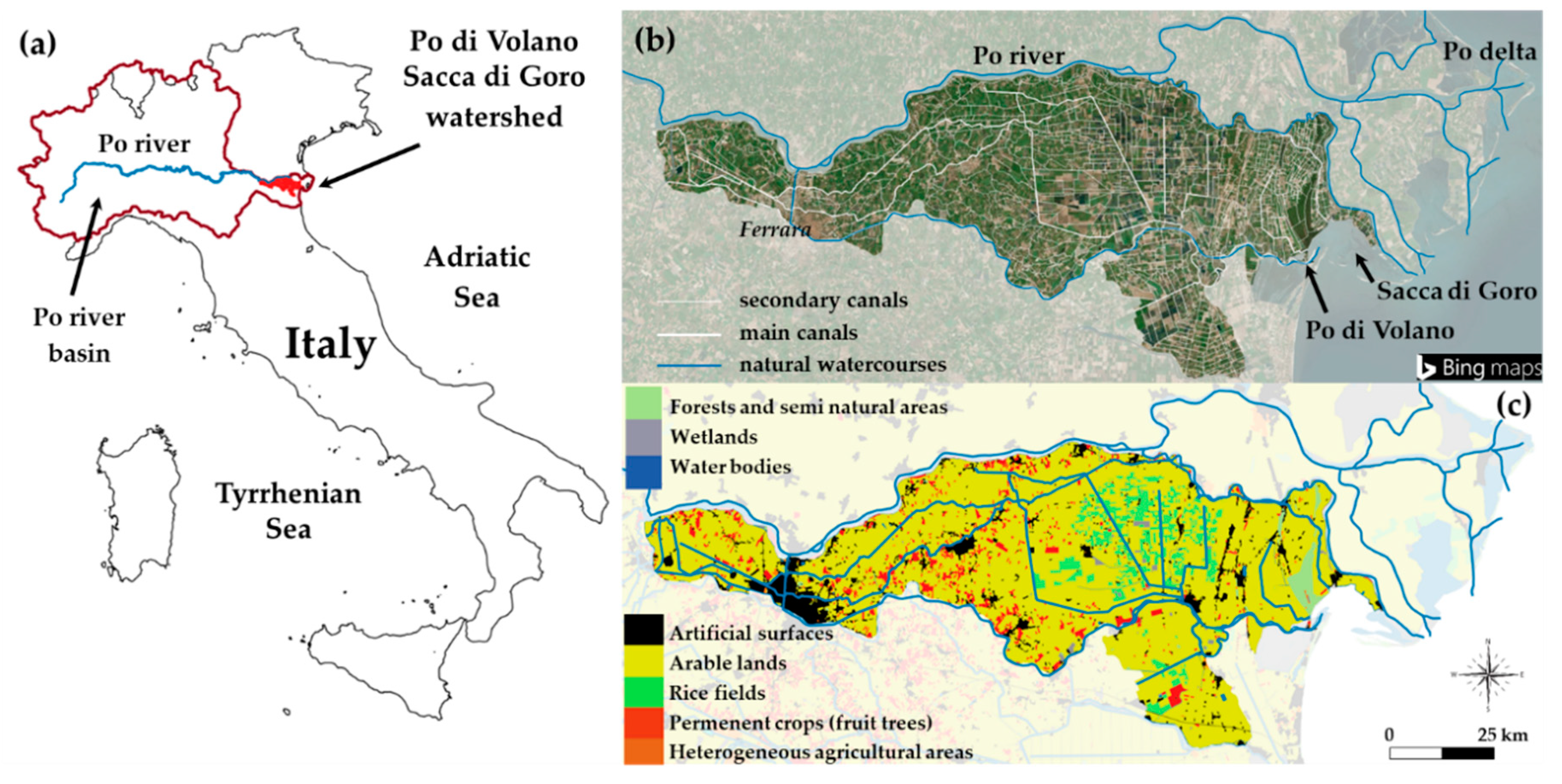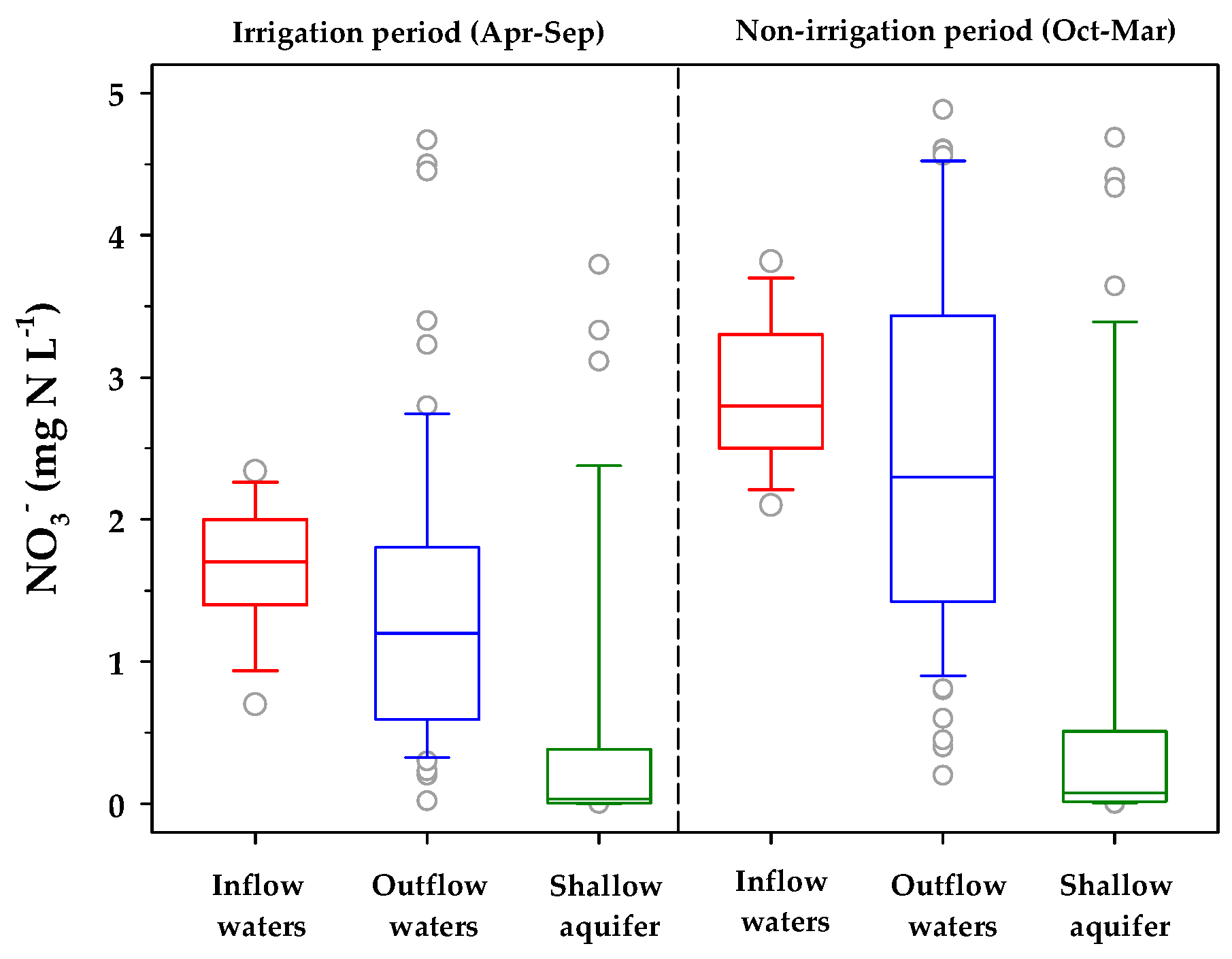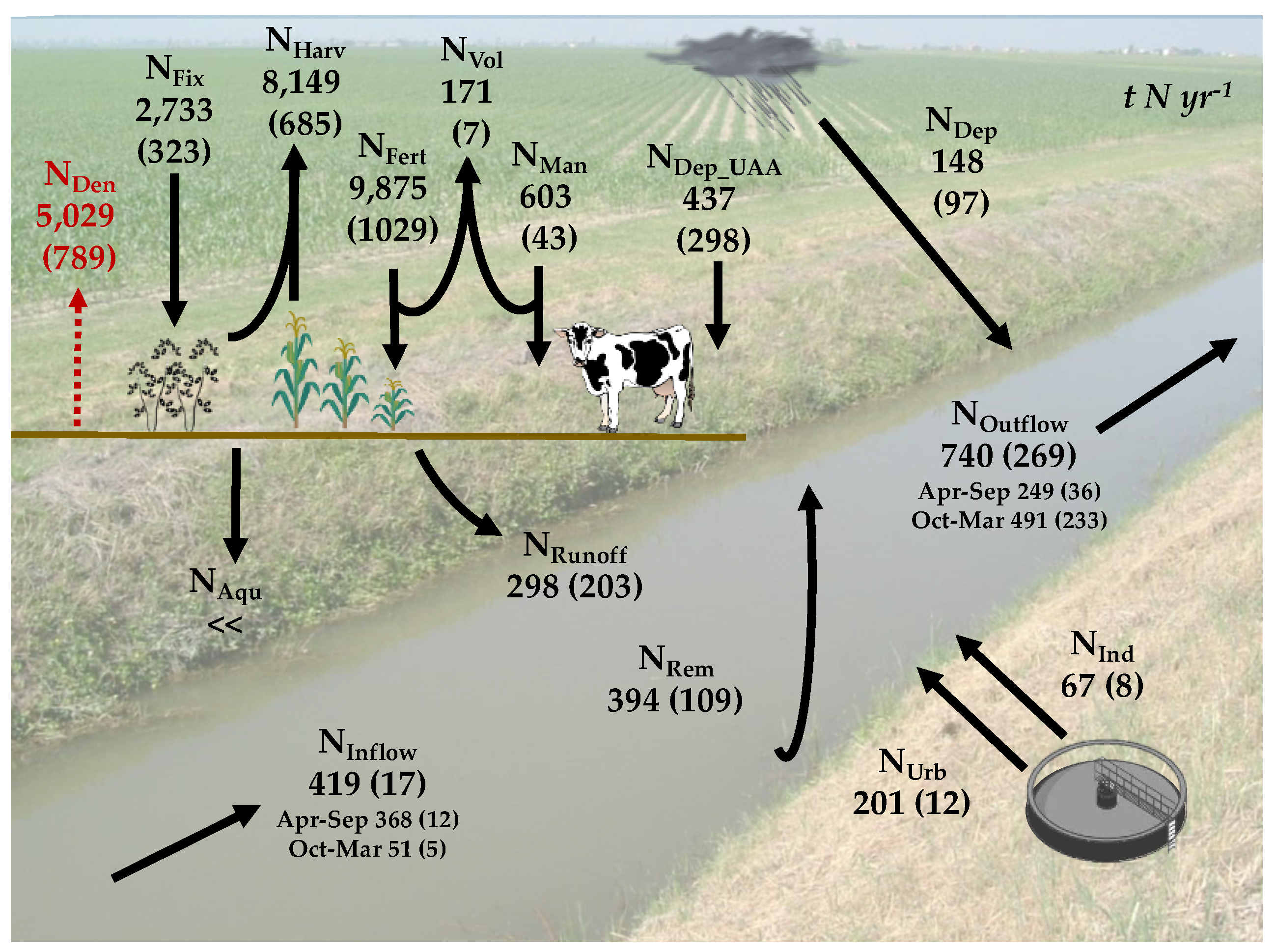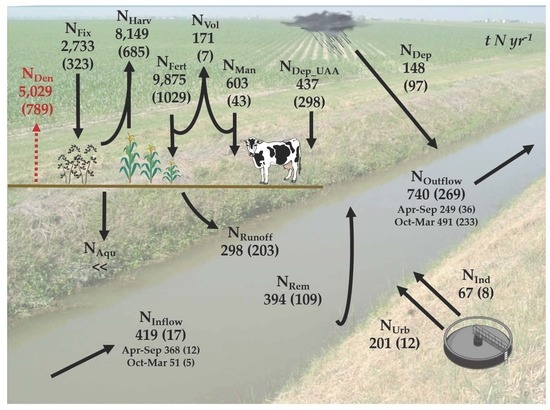In Search for the Missing Nitrogen: Closing the Budget to Assess the Role of Denitrification in Agricultural Watersheds
Abstract
1. Introduction
2. Materials and Methods
2.1. Study Area
2.2. N Budget in Agricultural Soils
2.3. N Budget in the Hydrological Network
3. Results
4. Discussion
Supplementary Materials
Author Contributions
Funding
Acknowledgments
Conflicts of Interest
References
- Townsend, A.R.; Howarth, R.W.; Bazzaz, F.A.; Booth, M.S.; Cleveland, C.C.; Collinge, S.K.; Dobson, A.P.; Epstein, P.R.; Holland, E.A.; Keeney, D.R.; et al. Human health effects of a changing global nitrogen cycle. Front. Ecol. Environ. 2003, 1, 240–246. [Google Scholar] [CrossRef]
- Erisman, J.W.; Galloway, J.; Seitzinger, S.; Bleeker, A.; Butterbach-Bahl, K. Reactive nitrogen in the environment and its effect on climate change. Curr. Opin. Environ. Sustain. 2011, 3, 281–290. [Google Scholar] [CrossRef]
- Houlton, B.Z.; Almaraz, M.; Aneja, V.; Austin, A.T.; Bai, E.; Cassman, K.G.; Gassman, J.E.; Compton, E.A.; Davidson, J.W.E.; James, N.G.; et al. A world of cobenefits: Solving the global nitrogen challenge. Earth’s Future 2019, 7, 865–872. [Google Scholar] [CrossRef] [PubMed]
- Glibert, P.M.; Harrison, J.; Heil, C.; Seitzinger, S. Escalating worldwide use of urea—A global change contributing to coastal eutrophication. Biogeochemistry 2006, 77, 441–463. [Google Scholar] [CrossRef]
- Rivett, M.O.; Buss, S.R.; Morgan, P.; Smith, J.W.; Bemment, C.D. Nitrate attenuation in groundwater: A review of biogeochemical controlling processes. Water Res. 2008, 42, 4215–4232. [Google Scholar] [CrossRef]
- Leip, A.; Billen, G.; Garnier, J.; Grizzetti, B.; Lassaletta, L.; Reis, S.; Simpson, D.; Sutton, M.A.; de Vries, W.; Weiss, F.; et al. Impacts of European livestock production: Nitrogen, sulphur, phosphorus and greenhouse gas emissions, land-use, water eutrophication and biodiversity. Environ. Res. Lett. 2015, 10, 115004. [Google Scholar] [CrossRef]
- Howarth, R.; Swaney, D.; Billen, G.; Garnier, J.; Hong, B.; Humborg, C.; Johnes, P.; Morth, C.-M.; Marino, R. Nitrogen fluxes from the landscape are controlled by net anthropogenic nitrogen inputs and by climate. Front. Ecol. Environ. 2012, 10, 37–43. [Google Scholar] [CrossRef]
- Goyette, J.O.; Bennett, E.M.; Howarth, R.W.; Maranger, R. Changes in anthropogenic nitrogen and phosphorus inputs to the St. Lawrence sub-basin over 110 years and impacts on riverine export. Glob. Biogeochem. Cycles 2016, 30, 1000–1014. [Google Scholar] [CrossRef]
- Romero, E.; Garnier, J.; Billen, G.; Peters, F.; Lassaletta, L. Water management practices exacerbate nitrogen retention in Mediterranean catchments. Sci. Total Environ. 2016, 573, 420–432. [Google Scholar] [CrossRef]
- Seitzinger, S.; Harrison, J.A.; Böhlke, J.K.; Bouwman, A.F.; Lowrance, R.; Peterson, B.; Tobias, C.; Drecht, G.V. Denitrification across landscapes and waterscapes: A synthesis. Ecol. Appl. 2006, 16, 2064–2090. [Google Scholar] [CrossRef]
- Kulkarni, M.V.; Groffman, P.M.; Yavitt, J.B. Solving the global nitrogen problem: it’s a gas. Front. Ecol. Environ. 2008, 6, 199–206. [Google Scholar] [CrossRef]
- Wang, C.; Houlton, B.Z.; Dai, W.; Bai, E. Growth in the global N2 sink attributed to N fertilizer inputs over 1860 to 2000. Sci. Total Environ. 2017, 574, 1044–1053. [Google Scholar] [CrossRef] [PubMed]
- Ascott, M.J.; Gooddy, D.C.; Wang, L.; Stuart, M.E.; Lewis, M.A.; Ward, R.S.; Binley, A.M. Global patterns of nitrate storage in the vadose zone. Nat. Commun. 2017, 8, 1416. [Google Scholar] [CrossRef] [PubMed]
- Almaraz, M.; Wong, M.Y.; Yang, W.H. Looking back to look ahead: A vision for soil denitrification research. Ecology 2019, 101, e02917. [Google Scholar] [CrossRef] [PubMed]
- Hofstra, N.; Bouwman, A.F. Denitrification in agricultural soils: Summarizing published data and estimating global annual rates. Nutr. Cycl. Agroecosyst. 2005, 72, 267–278. [Google Scholar] [CrossRef]
- Törnqvist, R.; Jarsjö, J.; Thorslund, J.; Rao, P.S.C.; Basu, N.B.; Destouni, G. Mechanisms of basin-scale nitrogen load reductions under intensified irrigated agriculture. PLoS ONE 2015, 10, e0120015. [Google Scholar] [CrossRef]
- Barakat, M.; Cheviron, B.; Angulo-Jaramillo, R. Influence of the irrigation technique and strategies on the nitrogen cycle and budget: A review. Agric. Water Manag. 2016, 178, 225–238. [Google Scholar] [CrossRef]
- Pierobon, E.; Castaldelli, G.; Mantovani, S.; Vincenzi, F.; Fano, E.A. Nitrogen removal in vegetated and unvegetated drainage ditches impacted by diffuse and point sources of pollution. CLEAN–Soil Air Water 2013, 41, 24–31. [Google Scholar] [CrossRef]
- Castaldelli, G.; Soana, E.; Racchetti, E.; Vincenzi, F.; Fano, E.A.; Bartoli, M. Vegetated canals mitigate nitrogen surplus in agricultural watersheds. Agric. Ecosyst. Environ. 2015, 212, 253–262. [Google Scholar] [CrossRef]
- Castaldelli, G.; Colombani, N.; Vincenzi, F.; Mastrocicco, M. Linking dissolved organic carbon, acetate and denitrification in agricultural soils. Environ. Earth Sci. 2013, 68, 939–945. [Google Scholar] [CrossRef]
- Castaldelli, G.; Colombani, N.; Soana, E.; Vincenzi, F.; Fano, E.A.; Mastrocicco, M. Reactive nitrogen losses via denitrification assessed in saturated agricultural soils. Geoderma 2019, 337, 91–98. [Google Scholar] [CrossRef]
- Mastrocicco, M.; Colombani, N.; Castaldelli, G.; Jovanovic, N. Monitoring and modeling nitrate persistence in a shallow aquifer. Water Air Soil Pollut. 2011, 217, 83–93. [Google Scholar] [CrossRef]
- Colombani, N.; Mastrocicco, M.; Castaldelli, G.; Aravena, R. Contrasting biogeochemical processes revealed by stable isotopes of H2O, N, C and S in shallow aquifers underlying agricultural lowlands. Sci. Total Environ. 2019, 691, 1282–1296. [Google Scholar] [CrossRef]
- Martinelli, G.; Dadomo, A.; De Luca, D.A.; Mazzola, M.; Lasagna, M.; Pennisi, M.; Sacchi, E.; Saccon, P. Nitrate sources, accumulation and reduction in groundwater from Northern Italy: Insights provided by a nitrate and boron isotopic database. Appl. Geochem. 2018, 91, 23–35. [Google Scholar] [CrossRef]
- Viaroli, P.; Soana, E.; Pecora, S.; Laini, A.; Naldi, M.; Fano, E.A.; Nizzoli, D. Space and time variations of watershed N and P budgets and their relationships with reactive N and P loadings in a heavily impacted river basin (Po river, Northern Italy). Sci. Total Environ. 2018, 639, 1574–1587. [Google Scholar] [CrossRef]
- Malagó, A.; Bouraoui, F.; Pastori, M.; Gelati, E. Modelling Nitrate Reduction Strategies from Diffuse Sources in the Po River Basin. Water 2019, 11, 1030. [Google Scholar] [CrossRef]
- Cencini, C. Physical processes and human activities in the evolution of the Po delta, Italy. J. Coast. Res. 1998, 14, 774–793. [Google Scholar]
- Mikhailova, M.V. The hydrological regime and the peculiarities of formation of the Po river delta. Water Resour. 2002, 29, 370–380. [Google Scholar] [CrossRef]
- Peel, M.C.; Finlayson, B.L.; McMahon, T.A. Updated world map of the Köppen-Geiger climate classification. Hydrol. Earth Syst. Sci. Discuss. 2007, 4, 439–473. [Google Scholar] [CrossRef]
- Viaroli, P.; Giordani, G.; Bartoli, M.; Naldi, M.; Azzoni, R.; Nizzoli, D.; Ferrari, I.; Zaldívar Comenges, J.M.; Bencivelli, S.; Castaldelli, G.; et al. The Sacca di Goro lagoon and an arm of the Po River. In Estuaries. The Handbook of Environmental Chemistry; Wangersky, P.J., Ed.; Springer: Berlin/Heidelberg, Germany, 2006; Volume 5H, pp. 197–232. [Google Scholar]
- Castaldelli, G.; Soana, E.; Racchetti, E.; Pierobon, E.; Mastrocicco, M.; Tesini, E.; Fano, E.A.; Bartoli, M. Nitrogen budget in a lowland coastal area within the Po river basin (Northern Italy): Multiple evidences of equilibrium between sources and internal sinks. Environ. Manag. 2013, 52, 567–580. [Google Scholar] [CrossRef]
- IUSS Working Group WRB. World Reference Base for Soil Resources. In World Soil Resources Reports; FAO: Rome, Italy, 2006; p. 103. [Google Scholar]
- Mastrocicco, M.; Colombani, N.; Salemi, E.; Castaldelli, G. Numerical assessment of effective evapotranspiration from maize plots to estimate groundwater recharge in lowlands. Agric. Water Manag. 2010, 97, 1389–1398. [Google Scholar] [CrossRef]
- Mastrocicco, M.; Colombani, N.; Salemi, E.; Castaldelli, G. Reactive modeling of denitrification in soils with natural and depleted organic matter. Water Air Soil Pollut. 2011, 222, 205–215. [Google Scholar] [CrossRef]
- de Vries, W.; Leip, A.; Reinds, G.J.; Kros, J.; Lesschen, J.P.; Bouwman, A.F. Comparison of land nitrogen budgets for European agriculture by various modeling approaches. Environ. Pollut. 2011, 159, 3254–3268. [Google Scholar] [CrossRef] [PubMed]
- Mastrocicco, M.; Di Giuseppe, D.; Vincenzi, F.; Colombani, N.; Castaldelli, G. Chlorate origin and fate in shallow groundwater below agricultural landscapes. Environ. Pollut. 2017, 231, 1453–1462. [Google Scholar] [CrossRef] [PubMed]
- Anglade, J.; Billen, G.; Garnier, J.; Makridis, T.; Puech, T.; Tittel, C. Nitrogen soil surface balance of organic vs conventional cash crop farming in the Seine watershed. Agric. Syst. 2015, 139, 82–92. [Google Scholar] [CrossRef]
- Minoli, S.; Acutis, M.; Carozzi, M. NH3 emissions from land application of manures and N-fertilisers: A review of the Italian literature. Ital. J. Agron. 2015, 3, 5–24. [Google Scholar]
- Castaldelli, G.; Colombani, N.; Tamburini, E.; Vincenzi, F.; Mastrocicco, M. Soil type and microclimatic conditions as drivers of urea transformation kinetics in maize plots. Catena 2018, 166, 200–208. [Google Scholar] [CrossRef]
- Schilke-Gartley, K.L.; Sims, J.T. Ammonia volatilization from poultry manure-amended soil. Biol. Fertil. Soils 1993, 16, 5–10. [Google Scholar] [CrossRef]
- Asman, W.A. Factors influencing local dry deposition of gases with special reference to ammonia. Atmos. Environ. 1998, 32, 415–421. [Google Scholar] [CrossRef]
- Bussink, D.W.; Oenema, O. Ammonia volatilization from dairy farming systems in temperate areas: A review. Nutr. Cycl. Agroecosyst. 1998, 51, 19–33. [Google Scholar] [CrossRef]
- Arcara, P.G.; Gamba, C.; Bidini, D.; Marchetti, R. The effect of urea and pig slurry fertilization on denitrification, direct nitrous oxide emission, volatile fatty acids, water-soluble carbon and anthrone-reactive carbon in maize-cropped soil from the Po plain (Modena, Italy). Biol. Fertil. Soils 1999, 29, 270–276. [Google Scholar] [CrossRef]
- Kronvang, B.; Bruhn, A.J. Choice of sampling strategy and estimation method for calculating nitrogen and phosphorus transport in small lowland streams. Hydrol. Process. 1996, 10, 1483–1501. [Google Scholar] [CrossRef]
- Letcher, R.A.; Jakeman, A.J.; Calfas, M.; Linforth, S.; Baginska, B.; Lawrence, I. A comparison of catchment water quality models and direct estimation techniques. Environ. Model. Softw. 2002, 17, 77–85. [Google Scholar] [CrossRef]
- Chu, Y.; Salles, C.; Cernesson, F.; Perrin, J.L.; Tournoud, M.G. Nutrient load modelling during floods in intermittent rivers: An operational approach. Environ. Modell. Softw. 2008, 23, 768–781. [Google Scholar] [CrossRef]
- Provini, A.; Galassi, S.; Marchetti, R. Città Studi Edizioni, Torino. Appl. Ecol. 1998, 1216. (In Italian) [Google Scholar]
- Pagnotta, R.; Barbiero, G. Assessment of pollutants load in the coastal environment. Annali ISS 2003, 39, 3–10. (In Italian) [Google Scholar]
- Soana, E.; Bartoli, M.; Milardi, M.; Fano, E.A.; Castaldelli, G. An ounce of prevention is worth a pound of cure: Managing macrophytes for nitrate mitigation in irrigated agricultural watersheds. Sci. Total Environ. 2019, 647, 301–312. [Google Scholar] [CrossRef]
- World Health Organization—WHO. Guidelines for Drinking Water Quality, 3rd ed.; IWA Publishing: London, UK, 2004. [Google Scholar]
- Bartoli, M.; Racchetti, E.; Delconte, C.A.; Sacchi, E.; Soana, E.; Laini, A.; Longhi, D.; Viaroli, P. Nitrogen balance and fate in a heavily impacted watershed (Oglio River, Northern Italy): In quest of the missing sources and sinks. Biogeosciences 2012, 9, 361–373. [Google Scholar] [CrossRef]
- Pinardi, M.; Soana, E.; Laini, A.; Bresciani, M.; Bartoli, M. Soil system budgets of N, Si and P in an agricultural irrigated watershed: Surplus, differential export and underlying mechanisms. Biogeochemistry 2018, 140, 175–197. [Google Scholar] [CrossRef]
- Aschonitis, V.G.; Salemi, E.; Colombani, N.; Castaldelli, G.; Mastrocicco, M. Formulation of indices to describe intrinsic nitrogen transformation rates for the implementation of best management practices in agricultural lands. Water Air Soil Pollut. 2013, 224, 1489. [Google Scholar] [CrossRef]
- Goeller, B.C.; Febria, C.M.; McKergow, L.A.; Harding, J.S.; Matheson, F.E.; Tanner, C.C.; McIntosh, A.R. Combining tools from edge-of-field to in-stream to attenuate reactive nitrogen along small agricultural waterways. Water 2020, 12, 383. [Google Scholar] [CrossRef]
- Mastrocicco, M.; Giambastiani, B.M.S.; Colombani, N. Ammonium occurrence in a salinized lowland coastal aquifer (Ferrara, Italy). Hydrol. Process. 2013, 27, 3495–3501. [Google Scholar] [CrossRef]
- Mastrocicco, M.; Colombani, N.; Vincenzi, F.; Castaldelli, G. Complex interactions between fertilizers and subsoils triggering reactive nitrogen speciation in lowlands. CAJG 2018. Advances in Science, Technology & Innovation (IEREK Interdisciplinary Series for Sustainable Development). In Advances in Sustainable and Environmental Hydrology, Hydrogeology, Hydrochemistry and Water Resources; Chaminé, H., Barbieri, M., Kisi, O., Chen, M., Merkel, B., Eds.; Springer: Cham, Germany, 2019; pp. 133–135. [Google Scholar] [CrossRef]
- Tiedje, J.M. Ecology of Denitrification and Dissimilatory Nitrate Reduction to Ammonium. In Biology of Anaerobic Microorganisms; Zehnder, A.J.B., Ed.; Wiley and Sons: New York, NY, USA, 1988; pp. 179–244. [Google Scholar]
- Wallenstein, M.D.; Myrold, D.D.; Firestone, M.; Voytek, M. Environmental controls on denitrifying communities and denitrification rates: Insights from molecular methods. Ecol. Appl. 2006, 16, 2143–2152. [Google Scholar] [CrossRef]
- Barton, L.; McLay, C.D.A.; Schipper, L.A.; Smith, C.T. Annual denitrification rates in agricultural and forest soils: A review. Soil Res. 1999, 37, 1073–1094. [Google Scholar] [CrossRef]
- Jessen, S.; Postma, D.; Thorling, L.; Müller, S.; Leskelä, J.; Engesgaard, P. Decadal variations in groundwater quality: A legacy from nitrate leaching and denitrification by pyrite in a sandy aquifer. Water Resour. Res. 2017, 53, 184–198. [Google Scholar] [CrossRef]



| Budget Item | Data Type | Sources |
|---|---|---|
| Livestock manure (NMan) | Livestock density | National Veterinary Information System of Livestock Registry (Annual Statistics, 2006–2009; https://www.vetinfo.it/j6_statistiche/#/), National Statistics Institution (6th Agricultural Census, 2010; http://dati-censimentoagricoltura.istat.it) |
| Animal live weights of N excretion rates | DM 07/04/2006, decree of the Italian Ministry of Agricultural and Forest Policies about agronomic utilization disciplinary | |
| Synthetic fertilizers (NFert) | Crop-specific fertilizer recommendations | EU-WATER project http://www.eu-water.eu/ |
| Utilized agricultural area by crop categories | Agriculture Department of Ferrara Province | |
| Biological N fixation (NFix) | Utilized agricultural area by crop categories | Agriculture Department of Ferrara Province |
| Crop yields, N uptake coefficients | Agriculture Department of Ferrara Province, Rural Development Program 2007–2013 of the Emilia-Romagna Region | |
| Atmospheric deposition (NDep_UAA, NDep) | Rainfall data | Hydro-Meteorological Service of the Environmental Protection Agency of the Emilia-Romagna Region (ARPA-SIMC meteorological databases 2006–2010; https://simc.arpae.it/dext3r/) |
| Rainfall N content | EU-WATER project (http://www.eu-water.eu/) | |
| Utilized agricultural area, total basin area | Agriculture Department of Ferrara Province | |
| Crop harvest (NHarv) | Utilized agricultural area by crop categories | Agriculture Department of Ferrara Province |
| Crop yields, N uptake coefficients | Agriculture Department of Ferrara Province, Rural Development Program 2007–2013 of the Emilia-Romagna Region | |
| Ammonia volatilization (NVol) | Loss of the N supplied by synthetic fertilizers | Experimental data for the study area from Reference [39] |
| Loss of the N supplied by livestock manure | Literature data from References [38,40,41,42,43] | |
| N load imported and exported by the canal network (NInflow, NOutflow) | Flow data | Consorzio di Bonifica Pianura di Ferrara |
| N concentration data | Emilia-Romagna Regional Agency for Environmental Protection (https://www.arpae.it/index.asp?idlivello=112) | |
| N load from urban areas (NUrb) | Resident population | National Statistics Institution (Annual Statistics, 2006–2010; http://demo.istat.it/) |
| N production coefficient | Literature data from Reference [47] | |
| N load from industrial areas (NInd) | Number of workers in N polluting industrial sectors | National Statistics Institution (8th and 9th Industrial Census, 2001 and 2011; http://dati.istat.it)/ |
| N production coefficients | Literature data from Reference [48] | |
| N removed by denitrification in the canal sediments (NRem) | Denitrification rates in vegetated and unvegetated canals | Experimental data for the study area from Reference [49] |
| Po di Volano-Sacca di Goro Watershed | N Budget | % | |
|---|---|---|---|
| t N·year−1 | kg N·ha−1·year−1 | ||
| INPUT | |||
| Livestock manure (NMan) | 603 (43) | 9 (1) | 5 |
| Synthetic fertilizers (NFert) | 9875 (1029) | 140 (12) | 72 |
| Biological fixation (NFix) | 2733 (323) | 39 (5) | 20 |
| Atmospheric deposition (NDep_UAA) | 437 (298) | 6 (4) | 3 |
| Σ input | 13,648 (987) | 194 (10) | |
| OUTPUT | |||
| Crop harvest (NHarv) | 8149 (685) | 116 (9) | 95 |
| NH3 volatilization (NVol) | 171 (7) | 2 (1) | 2 |
| N lost in runoff water (NRunoff) | 298 (203) | 4 (2) | 3 |
| Σ output | 8618 (749) | 121 (10) | |
| ΔNSoil = Σ input − Σ output | 5029 (789) | 72 (11) | |
© 2020 by the authors. Licensee MDPI, Basel, Switzerland. This article is an open access article distributed under the terms and conditions of the Creative Commons Attribution (CC BY) license (http://creativecommons.org/licenses/by/4.0/).
Share and Cite
Castaldelli, G.; Vincenzi, F.; Fano, E.A.; Soana, E. In Search for the Missing Nitrogen: Closing the Budget to Assess the Role of Denitrification in Agricultural Watersheds. Appl. Sci. 2020, 10, 2136. https://doi.org/10.3390/app10062136
Castaldelli G, Vincenzi F, Fano EA, Soana E. In Search for the Missing Nitrogen: Closing the Budget to Assess the Role of Denitrification in Agricultural Watersheds. Applied Sciences. 2020; 10(6):2136. https://doi.org/10.3390/app10062136
Chicago/Turabian StyleCastaldelli, Giuseppe, Fabio Vincenzi, Elisa Anna Fano, and Elisa Soana. 2020. "In Search for the Missing Nitrogen: Closing the Budget to Assess the Role of Denitrification in Agricultural Watersheds" Applied Sciences 10, no. 6: 2136. https://doi.org/10.3390/app10062136
APA StyleCastaldelli, G., Vincenzi, F., Fano, E. A., & Soana, E. (2020). In Search for the Missing Nitrogen: Closing the Budget to Assess the Role of Denitrification in Agricultural Watersheds. Applied Sciences, 10(6), 2136. https://doi.org/10.3390/app10062136









